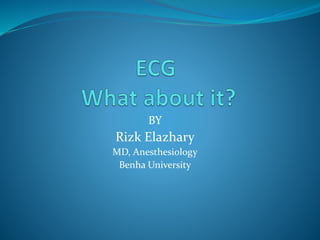
Cardiac Arrhythmias Guide
- 1. BY Rizk Elazhary MD, Anesthesiology Benha University
- 2. Introduction
- 3. Anatomy of Cardiac Conduction System
- 4. Physiology of the heart
- 5. Electrocardiogram Action potentials through myocardium during cardiac cycle produces electric currents than can be measured Pattern P wave Atria depolarization QRS complex Ventricle depolarization Atria repolarization T wave: Ventricle repolarization
- 9. Classification of Cardiac Arrhythmias Tachy arrhythmias(Fast). Brady arrhythmias(Slow). Regular-arrhythmias. Irregular-arrhythmias. Other arrhythmias.
- 11. The Six Step Approach What is the Rate? Is the Rhythm Regular? Are there P-Waves? Is the P-R Interval Normal? Is the QRS Complex Normal? Is There a P-Wave for Every QRS?
- 12. Normal Sinus Rhythm Rate: 60 - 100 Regularity: Very P-Waves: Present and Normal P-R I: 0.12-0.20 sec QRS: 0.04-0.12 sec and Normal 1 P: 1 QRS, no extras or shortages
- 13. Sinus Tachycardia Rate: Over 100 Regularity: Regular P-Waves: Present and Normal P-R I: 0.12-0.20 sec QRS: 0.04-0.12 sec and Normal 1 P: 1 QRS, no extras or shortages
- 14. Sinus Bradycardia Rate: Less than 60 Regularity: Regular P-Waves: Present and Normal P-R I: 0.12-0.20 sec QRS: 0.04-0.12 sec and Normal 1 P: 1 QRS, no extras or shortages
- 15. Atrial Fibrillation Rate: Usually tachy Regularity: Irregular (Irregularly irregular) P-Waves: Not Discernible P-R I: Undeterminable QRS: 0.04-0.12 sec P-QRS : Undeterminable
- 16. Atrial Flutter Rate: Usually tachy Regularity: Atria Regular • Ventricles May be Irregular P-Waves: Saw tooth Pattern 2:1, 3:1, 4:1... P-R I: 0.12-0.20 sec on conducting beat QRS: 0.04-0.12 sec P-waves outnumber QRS
- 17. (Paroxysmal) Supra Ventricular Tach Rate: 140-220 Regularity: Regular P-Waves: Usually falls within the QRS-T complex ( sometimes not visible) P-R I: Shorter than 0.12, or absent QRS: 0.04-0.12 sec and Normal P-QRS :Undeterminable
- 18. SVT WPW Usually based on Hx. Delta wave on Q Shortened PR-I No Verapamil – Accessory Path use increase
- 19. 1st Degree Heart Block Rate: 60 - 100 Regularity: Very P-Waves: Present and Normal P-R I: Longer than 0.20 sec QRS: 0.04-0.12 sec and Normal 1 P: 1 QRS, no extras or shortages
- 20. 2nd Degree Heart Block (Type 1) Wenkebach Rate: Can be Normal, or usually brady Regularity: Irregular P-Waves: Present and Normal P-R I: Lengthens until beat is dropped QRS: 0.04-0.12 sec and Normal P-wave present on conducting beats, increased delay causes missed QRS
- 21. 2nd Degree Heart Block (Type 2) Mobitz II Rate: Less than 60 Regularity: Irregular P-Waves: Present, 2:1, 3:1, 4:1 P-R I: 0.12-0.20 sec on conducting beat QRS: 0.04-0.12 sec, may begin to widen P-wave for every QRS and extras depending on conduction ratio
- 22. 3rd Degree Heart Block (CHB)Complete Heart Block Rate: Ventricular Rate 40-60 Regularity: Atria-Regular • Vent-Regular P-Waves: Present and Normal P-R I: Atria independent of Ventricles QRS: Usually greater than 0.12 sec P-waves completely unrelated to QRS Complexes.
- 23. Junctional Rhythm Rate: 40-60 Regularity: Regular P-Waves: Inverted, Retrograde or Absent P-R I: Shortened or absent QRS: 0.04-0.12 sec P-wave for every QRS, sometimes not visible
- 24. Ventricular Tachycardia Rate: 100-220 Regularity: Regular P-Waves: None P-R I: None QRS: Greater than 0.12 sec
- 25. Ventricular Fibrillation Rate: No ventricular rate Regularity: Irregular P-Waves: No P-R I: No QRS: No, unorganized ventricular baseline
- 26. Asystole Rate: 0 Regularity: N/A P-Waves: None P-R I: N/A QRS: None (check another lead)
- 27. Agonal / Idioventricular Rate: 20-40 Regularity: Irregular P-Waves: None P-R I: N/A QRS: Wider than 0.12 sec (a dying heart)
- 28. Other Arrhythmias Premature Ventricular Contractions Premature Atrial Contractions Bundle Branch Blocks Pacer Considerations (Atrial, Ventricular or Both)
- 29. Premature Ventricular Contractions Wide, Bizarre QRS Complex Always identify the underlying rhythm first Can appear in couplets, triplets, short runs of V-Tach, bigeminy and trigeminy Can be uni-focal or multi-focal Caused by random firing within the ventricles Not accompanied by a P-wave
- 30. PAC’s P-QRS Complex appearing in an unexpected location Caused by a stimulus from within the Atria, but not from the SA Node
- 31. Bundle Branch Block Any rhythm having a BBB will have a widened twin peaked R-Wave
- 34. QT Prolongation QT represents the ventricular refractory period Normal Men 450ms Women 460ms Corrected QT (QTc) QTm/√(R-R) Causes Drugs (Na channel blockers) Hypocalcemia, hypomagnesemia, hypokalemia Hypothermia AMI Congenital Increased ICP
- 35. Torsade de pointes Torsades de pointes is a polymorphic ventricular tachycardia . The phrase “torsades de pointes” means “twisting on a point” which explains the action of the QRS complex and how it varies from beat to beat. It is a shockable rhythm.
- 36. Normal Variants Always normal: Sinus Arrhythmia Supraventricular Extrasystoles Partial RBBB Often normal: Sinus Bradycardia (and pauses in athletes) First Degree Heart Block Ventricular Extrasystoles Left/Right Axis Deviation RBBB
- 37. Special Situations Dextrocardia – reverse precordial leads Large breasts – don't place electrodes on top of breast Bilateral breast implants you should apply V4, V5, and V6 close to the midaxillary line. Note patient abnormalities on ECG Do not place electrodes on open wounds, burns, or clear dressings Do not allow electrodes to touch one another
- 38. References Pictures and info from: Flip and See ECG, 2nd Edition Cohn/Gilroy-Doohan A great resource Paramedic Paramedic Textbook, Revised 2nd Edition Mick J. Sanders, Mosby ECG’s Made Easy, 2nd Edition Barbara Aehlert, RN, Mosby Basic Dysrhythmias, Interpretation and Management, 3rd Edition Robert J. Huszar, Mosby